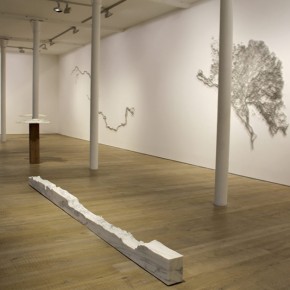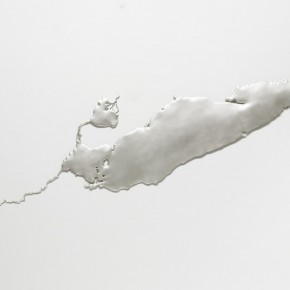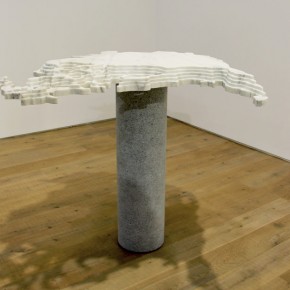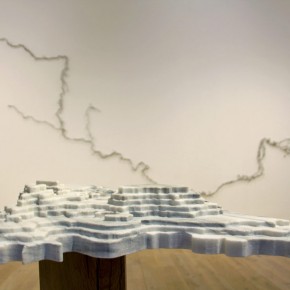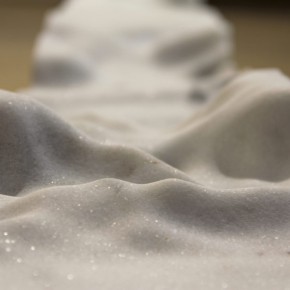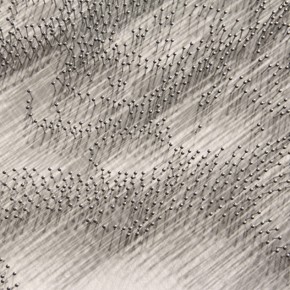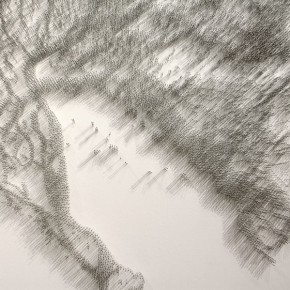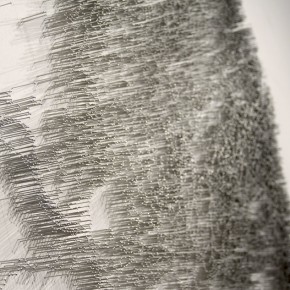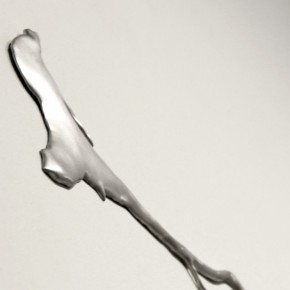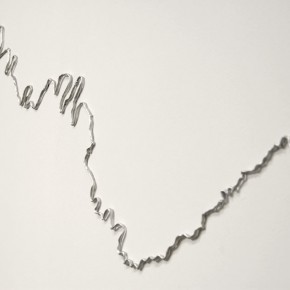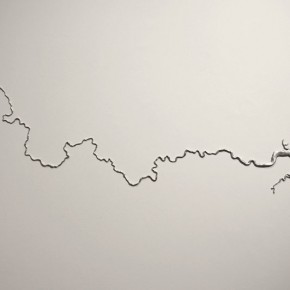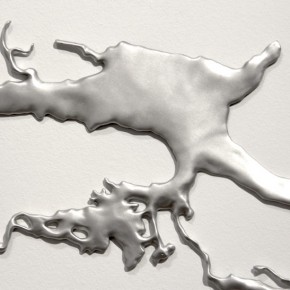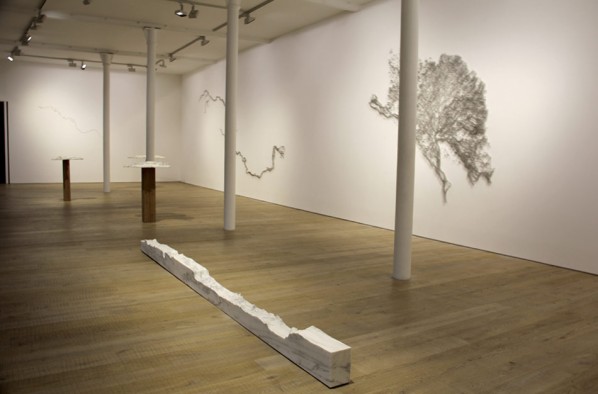
Employing technological methods to study and visualise topographies and geographic phenomena, Lin creates sculptures that interpret the natural world through a twenty-first century lens. By abstracting natural forms into a single material – marble, wood, silver, or steel – she reveals things that are often hidden below the surface or beyond sight, merging rational order with notions of beauty and the transcendental.
Lin’s Pin Rivers and Silver Rivers – wall works representing aerial views of waterways, in which the image of the river is made of either recycled silver or steel pins, with the wall forming the surrounding land – enable viewers to see rivers both as interconnected wholes and as dynamic, sculptural forms. The use of pins helps to represent the dispersion of the waterways, particularly evident in the evocative form of Pin River Sandy, representing the area flooded by Hurricane Sandy, and Crossing Midtown, which illustrates the path of two creeks that spanned what is now midtown Manhattan at the founding of New Amsterdam in the seventeenth century.
The exhibition also features marble sculptures of longitudinal and latitudinal sections that reveal the mountainous terrain above and below the ocean’s surface. The fourteen-foot-long marble sculpture Greenwich Mean Time represents the cartographic section of the Greenwich Meridian, the parallel passing through London at zero degrees longitude. To create the sculpture, Lin began with drawings, tracing the complex terrain of the ocean floor, followed by computer analysis and scaled models to find the right form before it is made in marble. “It’s a process that balances scientific data with the handmade,” says Lin. “If the end form looks only like the idea of the information, then it fails. It has to become its own form – evocative, beautiful, strange. I start with extremely complex scientific data points and then, through a visual editing process, I find the scale and simplicity of the form – revealing a landscape both visually discernible and compelling.”
The works 52 Ways to See the Ocean and 52 Ways to See the Earth illustrate fifty-two slices of the ocean's and the earth's topography, cut longitudinally. Made of Richlite, an environmentally friendly byproduct of wood, the maps function almost as puzzles, illustrating the peaks and valleys of the earth's land mass and the ocean floor.
The exhibition in London features a room dedicated to Lin’s last memorial, What is Missing?, a multi-sited artwork that raises awareness about the current crisis surrounding biodiversity and habitat loss. A website (www.whatismissing.net) acts as a nexus for the project, creating an ecological history of the planet and inviting people to share something they have personally witnessed diminish significantly or disappear from the natural world. At Pace in New York, the room will concentrate on the history of the Hudson River and the surrending area, revealing the former biological abundance of the waterway through details gleaned from historical documents and archives. At Pace London, meanwhile, the room explores the history of the Thames and of London and its environs. Visitors to the gallery are asked to contribute their own memories of the Thames, adding to the historical account.
Here and There will be accompanied by a catalogue with essays by Robert Storr, Dean of the Yale University School of Art, William L. Fox, Director of the Centre for Art + Environment at the Nevada Museum of Art, and notes by Maya Lin.Maya Lin (b. 1959, Athens, Ohio) is know for a wide-ranging practic that encompasses large-scale environmental installations, intimate studio artworks, architectural works, and memorials, after she virtually redefined the idea of the monument with her design for the Vietnam Veterans Memorial (1981). Lin graduated cum laude from Yale University with a Bachelor of Arts degree in 1981 and a Master of Architecture degree in 1986.
She has been the subject of solo exhibitions at museums worldwide, including the Wexner Center for the Arts, Columbus; American Academy in Rome, Wanås Foundation, Kinslinge, Sweden; the Carnegie Museum of Art, Pittsburgh; Arts Club of Chicago; and the Henry Art Gallery, Seattle, which traveled to the Contemporary Art Museum, St. Louis; Museum of Contemporary Art San Diego, etc. She has created permanent outdoor installations for public and private collections, including the California Academy of Sciences, San Francisco (San Francisco Arts Commission for the Civic Art Collection, California); the Wanås Foundation, the Wexner Center for the Arts, Columbus; her acclaimed Wave Field at Storm King Art Center, Mountainville, New Yokr, and her largest earthwork to date, unveiled in New Zealand this spring.
A dedicated environmentalist, Lin has been committed to focusing attention on the natural world throughout her career, and has incorporated sustainable and recycled material into many of her artworks. She currently serves on the Board of Trustees of the Natural Resources Defense Council and Museum of Chinese in America, and is a former member of the boards of both the Yale Corporation and the Energy Foundation.
She is the recipient of numerous prizes and awards, and has received honorary doctorates from Yale and Harvard Universities, and Smith College, among other. Lin a a member of the American Academy of Arts and Letter and the American Academy of Arts and Sciences, and was introduced into the National Women’s Hall of Fame in 2005. On April 9, Maya Lin will present a convocation address at Oberlin College’s Finney Chapel, the first visual artist to be so honored.
Courtesy of the artist and Pace Gallery, for more information about the exhibition and Maya Lin, please visit www.pacegallery.com or contact Sarah Goulet at 212.421.8987/sgoulet@pacegallery.com.
For general inquires, please email newyork@pacegallery.com.


